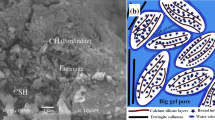Abstract
Water molecular dynamics in a hardened Portland cement were characterized by proton Fourier transform nuclear magnetic resonance (NMR) at 400 MHz. Three different types of water molecule (physically bound, chemically bound and porous trapped) were observed. When the hardened cement sample was heated at 105 °C, the physically bound water diffused out of the sample as a function of the heating time while the chemically bound water remained in a stable form. A trace amount of the porously trapped water was also detected to remain in the cavities of the hardened cement even after heating for up to 20 h at this temperature. The loss of the physically bound water proved to be a diffusion-controlled process as evidenced from the NMR data and from a gravimetric technique. A Pake doublet was observed in the NMR spectra. This is a result of the oscillation of the water molecules with hindered molecular motions due to their entrapment in the cement pores. Soaking the dried samples in water resulted in the diffusion of water back into the hardened cement as physically bound water. Nuclear spin–spin relaxation time, T2-weighted imaging showed that the distribution of the physically bound water inside the cylindrical sample formed a doughnut shape after overnight soaking. The residual air in the cement pores may have slowed down the diffusion rate of the water molecules back into the dried cement. © 1998 Kluwer Academic Publishers
Similar content being viewed by others
References
F. M. Lea, “The chemistry of cement and concrete” (Chemical Publishing Company, New York, 3rd Edn, 1971).
A. M. Neville, “Properties of concrete” (Pitman Press, Bath, 1972).
D. P. Bentz and E. J. Garboczi, Cement Concr. Res. 21 (1991) 325.
M. Geiker, PhD thesis, Technical University of Denmark, Lyngby (1983).
H. F. W. Taylor, “Cement chemistry” (Academic Press, London, 1990).
P. Colombet and A. R. Grimmer, “Application of NMR spectroscopy to cement science” (Gordon and Breach, New York, 1994).
G. Papavassiliou, F. Milia, M. Fardis, R. Rumm and E. Laganas, J. Amer. Ceram. Soc. 76 (1993) 2109.
J. C. Mactavish, L. Miljkovic, M. M. Pintar, R. Blinc and G. Lahajnar, Cement. Concr. Res. 15 (1985) 367.
D. D. Lasic, M. M. Pintar and R. Blinc, Phil. Mag. Lett. 58 (1988) 227.
S. Bhattacharja, M. Moukwa, F. Dorazio, J. Yehng and W. P. Halperin, Adv. Cement Based Mater. 1 (1993) 67.
S. Bhattacharja, F. D'orazio, J. C. Tarczon and W. P. Halperin, J. Amer. Ceram. Soc. 72 (1989) 2126.
F. D'orazio, J. C. Tarczon, W. P. Halperin, K. Eguchi and T. Mizusaki, J. Appl. Phys. 65 (1989) 742.
A. B. Kudrjavtsev, T. V. Kouznetsova and A. V. Pyatkova, Cement. Concr. Res. 20 (1990) 407.
T. V. Kouznetsova and A. V. Pyatkova, V. G. Akimov and A. B. Kudrjavtsev, Trudy Musk. Khim.-Tekhnol. Inst. 137 (1987) 101.
L. H. Bennett, P. S. Wang and M. J. Donahue, J. Appl. Phys. 79 (1996) 4712.
P. S. Wang, D. B. Minor and S. G. Malghan, J. Mater. Sci. 28 (1993) 4940.
P. S. Wang, S. G. Malghan, S. J. Dapkunas, K. F. Hens and R. Raman, ibid. 30 (1995) 1059.
Idem., ibid. 30 (1995) 1069.
P. S. Wang, J. Mater. Sci. (1996) submitted.
D. D. Ellman and D. Williams, J. Chem. Phys. 25 (1956) 742.
J. A. Moreno, S. Mizrachi and V. Oppeltz, Solid State Commun. 51 (1984) 597.
F. Holuj and J. Wieczorek, Can. J. Phys. 55 (1977) 654.
D. M. Henderson and H. S. Gutowsky, Am. Mineralogist 47 (1962) 1231.
G. E. Pake, J. Chem. Phys. 16 (1948) 327.
F. Bloch, Phys. Rev. 70 (1946) 460.
C. P. Slichter, “Principles of magnetic resonance” (Springer, Berlin, 1989) Chapter 2.
P. S. Wang, (1998) to be published.
Author information
Authors and Affiliations
Rights and permissions
About this article
Cite this article
Wang, P.S., Ferguson, M.M., Eng, G. et al. 1H nuclear magnetic resonance characterization of Portland cement: molecular diffusion of water studied by spin relaxation and relaxation time-weighted imaging. Journal of Materials Science 33, 3065–3071 (1998). https://doi.org/10.1023/A:1004331403418
Issue Date:
DOI: https://doi.org/10.1023/A:1004331403418




